Loose Indian Diamonds
In total, there are thousands of loose diamonds on display in the treasury. Many of these diamonds were brought from India by Nader Shah. It is assumed that these diamonds were mined during the Mughol dynasty in India. Of the thousands of diamonds, only three have a verifiable history: the Darya-e Noor ("Sea of Light"), the Noor-ol-Ain which in now incorporated in a tiara, and the Taj Mah diamond which is shown here on the lower left. It weighs 115 cts.
The other three loose diamonds shown here are 72.5 cts., 54.5 cts., 47.5 cts., and 54.35 cts. The one on the top left was probably cut from an even larger diamond.
















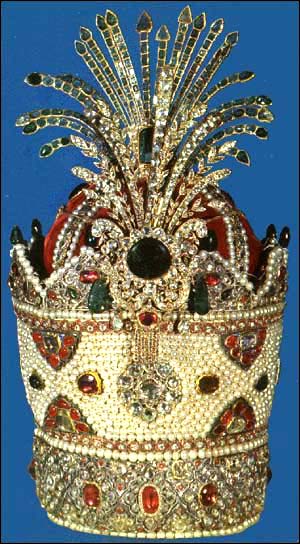



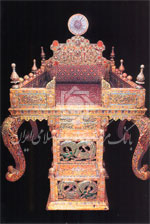 During the reign of Fath-Ali Shah and by his order, a great throne was made under the supervision of Nezamoldoleh Mohammad Hossein Khan Sadr Esfahani, the governor of Isfahan. Using gold and the loose stones of the treasury. (Early 19th century). As a design of sun encrusted with precious stones was used at the top of the throne, it became famous as the “Sun Throne”. After the marriage of Fath-AliShah with Tavous Tajodoleh, due to her name, the throne was named “Peacock Throne”. Some Iranians thought that the above throne was the same brought from India but according to the definition of Tavernier from “Peacock Throne” and their own gatherings they came to the conclusion that it can not be the genuine “Peacock Throne.” In order to confirm this view, they discussed the matter with Nasser-ed-din Shah and at last became sure that this “Peacock Throne” was constructed by the order of Fath-Ali Shah and was named after his favorite wife Tavous Khanoum or Lady Peacock as “Peacock Throne”.
During the reign of Fath-Ali Shah and by his order, a great throne was made under the supervision of Nezamoldoleh Mohammad Hossein Khan Sadr Esfahani, the governor of Isfahan. Using gold and the loose stones of the treasury. (Early 19th century). As a design of sun encrusted with precious stones was used at the top of the throne, it became famous as the “Sun Throne”. After the marriage of Fath-AliShah with Tavous Tajodoleh, due to her name, the throne was named “Peacock Throne”. Some Iranians thought that the above throne was the same brought from India but according to the definition of Tavernier from “Peacock Throne” and their own gatherings they came to the conclusion that it can not be the genuine “Peacock Throne.” In order to confirm this view, they discussed the matter with Nasser-ed-din Shah and at last became sure that this “Peacock Throne” was constructed by the order of Fath-Ali Shah and was named after his favorite wife Tavous Khanoum or Lady Peacock as “Peacock Throne”.
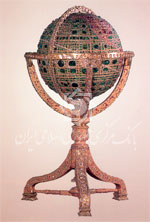
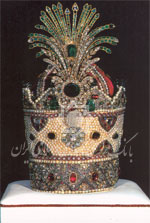
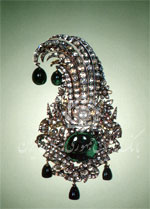
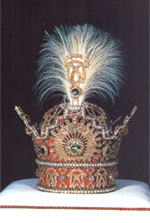 Crown used by Reza Khan and Mohammad Reza Pahlavi. This crown is made of gold and silver, and decorated with diamonds, emeralds, sapphires and pearls. The fabric of the crown is red velvet. On the 4 sides of the crown are battlement designs and also sunbursts on the four panels, totally set in diamonds. The general design is in the style of the crown of the Sassanid kings (226-651 AD). Inside the front sun design, there is a very large yellow diamond. The total number of the precious stones set in this crown is as follows:
Crown used by Reza Khan and Mohammad Reza Pahlavi. This crown is made of gold and silver, and decorated with diamonds, emeralds, sapphires and pearls. The fabric of the crown is red velvet. On the 4 sides of the crown are battlement designs and also sunbursts on the four panels, totally set in diamonds. The general design is in the style of the crown of the Sassanid kings (226-651 AD). Inside the front sun design, there is a very large yellow diamond. The total number of the precious stones set in this crown is as follows: The famous Darya-i-Nur or Sea of light is the largest pink diamond of the world and takes the first place among the diamonds in the National Treasury of Iran. This famous diamond along with its mate, the Kooh-i-Nur, or Mountain of Light, perhaps due to similarity of names, has always come together in history, although there is no similarity in cut or color between these two diamonds. Both of these stones were in the possession of Nadir Shah. After his death, Ahmad Shah Durrani took Kooh-i-Nur ti Afghanistan. After Ahmad Shah, it passed on to Shah Shuja, and after the defeat of Shah Shuja by Ranjit Singh the Lion of the Punjab, it passed into his possession. Later East India Company obtained it and presented it as a gift to Queen Victoria. It is presently in the Queen Mother’s Crown in England.
The famous Darya-i-Nur or Sea of light is the largest pink diamond of the world and takes the first place among the diamonds in the National Treasury of Iran. This famous diamond along with its mate, the Kooh-i-Nur, or Mountain of Light, perhaps due to similarity of names, has always come together in history, although there is no similarity in cut or color between these two diamonds. Both of these stones were in the possession of Nadir Shah. After his death, Ahmad Shah Durrani took Kooh-i-Nur ti Afghanistan. After Ahmad Shah, it passed on to Shah Shuja, and after the defeat of Shah Shuja by Ranjit Singh the Lion of the Punjab, it passed into his possession. Later East India Company obtained it and presented it as a gift to Queen Victoria. It is presently in the Queen Mother’s Crown in England.